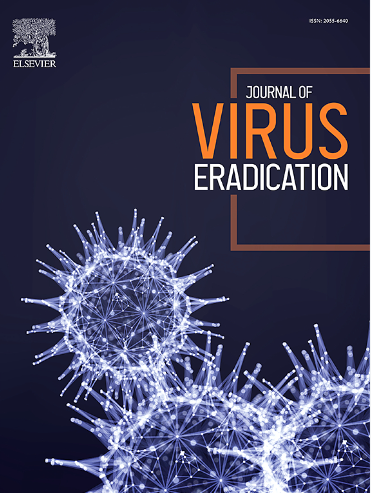乌干达慢性乙型肝炎的管理:启动国家宣传和护理运动后的五年经验
IF 3.5
4区 医学
Q2 IMMUNOLOGY
引用次数: 0
摘要
尽管撒哈拉以南非洲(SSA)是全球乙型肝炎病毒(HBV)相关死亡率最高的地区,但其疾病消除运动进展缓慢。我们描述了乌干达一家大型机构5年的HBV管理经验,以及它如何为未来的管理战略提供信息。从临床记录中提取与hbv相关的患者数据。在2664例患者中,1828例(68.6%)有慢性HBV感染记录。参与者年轻,平均年龄(±SD) 31.3(±10.6),按性别平均分配。总体而言,423人(23.1%)接受抗病毒药物治疗,其中超声诊断为肝硬化的158/229人(69.0%)和天门冬氨酸转氨酶与血小板比值指数(APRI)评分≥0.5.48/1828人(2.6%)患有肝细胞癌(HCC)的130/282人(46.1%)。在多变量分析中,APRI评分≥0.5 [OR (95% CI) = 1.76 (1.26-2.46), p <;0.01],谷丙转氨酶(ALT)升高[OR (95% CI) = 2.25 (1.35-4.47), p = 0.04], HBV病毒载量≥2000 iu /mL [OR (95% CI) = 2.97 (1.68-5.22), p <;0.01]是肝硬化/HCC的预测因子。也,APRI分数≥0.5(或1.62(95%置信区间)= (1.19 - -2.22),p = 0.01), ALT升高(或(95% CI) = 2.60 (1.23 - -5.49), p = 0.02),肝硬化(或(95% CI) = 21.65 (9.26 - -50.59), p & lt;0.01),病毒载量≥2000国际单位/毫升(或(95% CI) = 6.62 (3.93 - -11.15), p & lt;0.01]与抗病毒药物使用相关。在SSA中,肝硬化/HCC明显发生在较低的APRI评分中,这表明迫切需要采用2024年世卫组织指南,该指南规定早期开始抗hbv治疗。本文章由计算机程序翻译,如有差异,请以英文原文为准。
Management of chronic hepatitis B in Uganda: A five-year experience following the initiation of a national sensitization and care campaign
Despite having the highest Hepatitis B Virus (HBV)-related mortality globally, sub-Saharan Africa (SSA) has been slow in its disease elimination campaign. We describe a 5-year experience in HBV management at a large facility in Uganda and how it can inform future management strategies.
HBV-related patient data were abstracted from clinic records. Of 2664 patients, 1828 (68.6 %) had documented chronic HBV infection. Participants were young, mean age (±SD) 31.3 (±10.6) and equally split by gender. Overall, 423 (23.1 %) were on antiviral medications including 158/229 (69.0 %) with a sonographic diagnosis of cirrhosis and 130/282 (46.1 %) with Aspartate aminotransferase to Platelet Ratio Index (APRI) score ≥0.5.48/1828 (2.6 %) had Hepatocellular Carcinoma (HCC).
In multivariable analysis, APRI score ≥0.5 [OR (95 % CI) = 1.76 (1.26–2.46), p < 0.01], elevated alanine aminotransferase (ALT) [OR (95 % CI) = 2.25 (1.35–4.47), p = 0.04], and HBV viral load ≥2,000IU/mL [OR (95 % CI) = 2.97 (1.68–5.22), p < 0.01] were predictors of cirrhosis/HCC. Also, an APRI score of ≥0.5 [OR (95 % CI) = 1.62 (1.19–2.22), p = 0.01], elevated ALT [OR (95 % CI) = 2.60 (1.23–5.49), p = 0.02], cirrhosis [OR (95 % CI) = 21.65 (9.26–50.59), p < 0.01], and viral load ≥2,000IU/mL [OR (95 % CI) = 6.62 (3.93–11.15), p < 0.01] were associated with antiviral use.
Cirrhosis/HCC apparently occur at lower APRI scores in SSA suggesting need for urgent adoption of the 2024 WHO guidelines which provide for earlier initiation of anti-HBV therapy.
求助全文
通过发布文献求助,成功后即可免费获取论文全文。
去求助
来源期刊

Journal of Virus Eradication
Medicine-Public Health, Environmental and Occupational Health
CiteScore
6.10
自引率
1.80%
发文量
28
审稿时长
39 weeks
期刊介绍:
The Journal of Virus Eradication aims to provide a specialist, open-access forum to publish work in the rapidly developing field of virus eradication. The Journal covers all human viruses, in the context of new therapeutic strategies, as well as societal eradication of viral infections with preventive interventions.
The Journal is aimed at the international community involved in the prevention and management of viral infections. It provides an academic forum for the publication of original research into viral reservoirs, viral persistence and virus eradication and ultimately development of cures.
The Journal not only publishes original research, but provides an opportunity for opinions, reviews, case studies and comments on the published literature. It focusses on evidence-based medicine as the major thrust in the successful management of viral infections.The Journal encompasses virological, immunological, epidemiological, modelling, pharmacological, pre-clinical and in vitro, as well as clinical, data including but not limited to drugs, immunotherapy and gene therapy. It is an important source of information on the development of vaccine programs and preventative measures aimed at virus eradication.
 求助内容:
求助内容: 应助结果提醒方式:
应助结果提醒方式:


